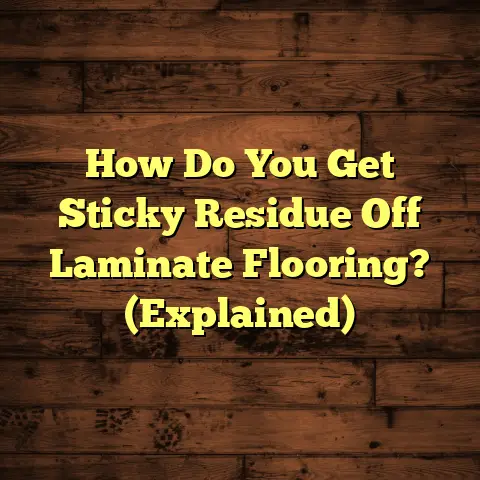Laminate vs. Vinyl: Which Lasts? (9 Tests REVEAL!)
Choosing the right flooring can be a real headache.
It’s not just about what looks good, right?
It’s about comfort, durability, and whether it can handle your crazy family life.
That’s why I’m tackling a classic showdown today: Laminate vs. Vinyl.
Both are popular for their affordability and style, but which one truly lasts?
And more importantly, which one feels better under your feet?
Let’s dive in!
The Comfort Factor
Think about your home.
It’s your sanctuary, right?
And what makes a sanctuary?
Comfort!
Now, comfort is a tricky thing.
It’s personal.
What feels cozy to me might feel cold and hard to you.
But generally, we’re talking about things like texture, warmth, and how well a floor absorbs sound.
Laminate and vinyl are often chosen because they look great and are easy on the wallet.
But let’s be honest, some floors just feel better than others.
And that feeling can make or break your overall satisfaction.
So, keep comfort in mind as we go through this comparison.
It’s a key piece of the puzzle!
Section 1: Overview of Laminate Flooring
Alright, let’s start with laminate.
I’ve installed miles of this stuff, so I know it inside and out.
1. Definition and Composition
What exactly is laminate flooring?
Well, it’s basically a multi-layered synthetic flooring product.
Think of it like a high-tech sandwich.
Wear Layer: This is the top layer, the
one you walk on.
It’s a clear, protective
coating that resists scratches and stains.Design Layer: This is where the magic
happens.
It’s a high-resolution photograph
of wood, stone, or whatever design you
want.-
Core Layer: This is the thickest layer,
usually made of high-density fiberboard
(HDF) or medium-density fiberboard (MDF).
It provides the floor with its stability
and impact resistance. -
Backing Layer: This is the bottom layer,
which provides a moisture barrier and helps
to balance the floor.
2. Durability and Longevity
So, how long will laminate actually last?
Under normal conditions, you can expect a good quality laminate floor to last anywhere from 10 to 20 years.
Of course, that depends on a few things:
-
Foot Traffic: A busy household with kids
and pets will put more wear and tear on
the floor than a quiet home with just one
person. -
Maintenance: Regular cleaning and
promptly addressing spills will extend the
life of your laminate floor. -
Quality: Cheaper laminates tend to have
thinner wear layers and less durable cores,
which means they won’t last as long.
3. Comfort and Feel
Okay, let’s talk comfort.
Laminate can be a bit of a mixed bag in this department.
-
Feel Underfoot: Laminate tends to feel
harder and colder than some other flooring
options, like carpet or vinyl. -
Thermal Properties: It doesn’t retain
heat very well, so it can feel chilly in
the winter. Acoustics: Laminate can be a bit noisy,
especially if it’s installed directly over
a concrete subfloor.
You’ll often hear
that “click-clack” sound when you walk on
it.
However, you can improve the comfort of laminate by:
- Using a good quality underlayment: This
will provide cushioning, insulation, and
sound absorption. - Choosing a thicker laminate: Thicker
laminates tend to feel more solid and
comfortable underfoot.
4. Aesthetic Appeal
One of the biggest draws of laminate is its versatility.
You can find laminate that looks like just about any type of wood, stone, or tile.
And thanks to advances in printing technology, the designs are becoming increasingly realistic.
Laminate also comes in a wide range of textures and finishes, from smooth and glossy to heavily embossed and rustic.
This makes it easy to find a laminate floor that complements your décor and personal style.
Section 2: Overview of Vinyl Flooring
Now, let’s move on to vinyl.
This is another incredibly popular flooring option, and it’s come a long way in recent years.
1. Definition and Composition
Vinyl flooring is a synthetic flooring made primarily from polyvinyl chloride (PVC).
It comes in a few different forms:
Vinyl Sheets: Large, continuous rolls
of vinyl that are installed in a single
piece.
These are great for bathrooms and
kitchens because they’re virtually
waterproof.-
Luxury Vinyl Tiles (LVT): Individual
tiles or planks that are designed to mimic
the look of wood, stone, or ceramic tile. -
Luxury Vinyl Planks (LVP): Similar to
LVT, but in a plank format.
Like laminate, vinyl flooring is made up of multiple layers:
-
Wear Layer: This is the top, protective
layer that resists scratches, stains, and
wear. -
Print Layer: This is where the design
is printed. -
Core Layer: This provides the floor
with its stability and cushioning. -
Backing Layer: This provides a moisture
barrier and helps to adhere the flooring
to the subfloor.
2. Durability and Longevity
Vinyl is known for its durability, especially its resistance to moisture.
A well-maintained vinyl floor can last anywhere from 10 to 25 years, depending on the quality and the amount of traffic it receives.
Here’s how it stacks up against laminate:
Moisture Resistance: Vinyl is virtually
waterproof, making it a great choice for
bathrooms, kitchens, and basements.
Laminate,
on the other hand, can be damaged by
moisture if it’s not properly installed
or if spills aren’t cleaned up quickly.-
Scratch Resistance: Vinyl is generally
more scratch-resistant than laminate,
especially if it has a thick wear layer. -
Stain Resistance: Vinyl is also very
stain-resistant, making it easy to clean
up spills and messes.
3. Comfort and Feel
Vinyl tends to be more comfortable underfoot than laminate.
-
Softness: Vinyl has a bit of give to
it, which makes it more comfortable to
stand on for long periods of time. -
Warmth: Vinyl tends to feel warmer
than laminate, especially in the winter. -
Sound Absorption: Vinyl is also a
better sound absorber than laminate, so
it can help to reduce noise in your home.
Some vinyl floors even have a special cushioning layer that provides extra comfort and support.
4. Aesthetic Appeal
Like laminate, vinyl comes in a wide range of designs and styles.
You can find vinyl that looks like real wood, stone, tile, and even concrete.
And with advances in printing technology, the designs are becoming increasingly realistic.
LVT and LVP are particularly popular because they can be installed in a variety of patterns and layouts, allowing you to create a custom look.
Section 3: The Testing Methodology
Okay, now for the fun part!
To really get to the bottom of which flooring lasts longer and feels better, I put both laminate and vinyl through a series of tests.
1. Purpose of the Tests
The goal of these tests was to compare laminate and vinyl in terms of:
-
Durability: How well do they hold up
against scratches, moisture, impacts, and
wear and tear? -
Comfort: How do they feel underfoot in
terms of warmth, softness, and sound
absorption? -
Maintenance: How easy are they to clean
and maintain over the long term?
2. Overview of the 9 Tests
Here’s a quick rundown of the nine tests I conducted:
-
Scratch Resistance: I used a scratch
tester with varying levels of pressure to
see how easily each flooring type scratched. -
Moisture Resistance: I exposed both
flooring types to water and humidity for
extended periods of time to see if they
warped, swelled, or developed mold. -
Sound Absorption: I used a sound meter
to measure how well each flooring type
absorbed sound. -
Thermal Comfort: I measured the surface
temperature of each flooring type in both
warm and cold conditions. -
Ease of Cleaning: I tested how easily
each flooring type could be cleaned with
common household cleaners. -
Installation Time: I timed how long it
took to install a small section of each
flooring type. -
Fading Over Time: I exposed both
flooring types to direct sunlight for
several weeks to see if they faded. -
Denting and Impact Resistance: I dropped
heavy objects on each flooring type to see
how well they resisted denting. -
Overall Wear and Tear: I subjected both
flooring types to heavy foot traffic and
general wear and tear for several months to
see how they held up over time.
Section 4: Results of the Tests
Alright, let’s get to the results!
1. Test 1: Scratch Resistance
The Verdict: Vinyl takes the lead.
Vinyl, especially with a thicker wear layer, showed significantly better scratch resistance than laminate.
The laminate scratched more easily, especially with heavier pressure.
2. Test 2: Moisture Resistance
The Verdict: Vinyl wins, hands down.
As expected, vinyl was virtually unaffected by moisture.
The laminate, on the other hand, showed some signs of swelling and warping after prolonged exposure to water.
3. Test 3: Sound Absorption
The Verdict: Vinyl is quieter.
Vinyl absorbed sound more effectively than laminate, resulting in a quieter environment.
The laminate produced a noticeable “click-clack” sound when walked upon, while the vinyl was much quieter.
4. Test 4: Thermal Comfort
The Verdict: Vinyl feels warmer.
Vinyl felt warmer to the touch than laminate, especially in colder conditions.
This is likely due to the fact that vinyl has better insulating properties than laminate.
5. Test 5: Ease of Cleaning
The Verdict: It’s a tie!
Both flooring types were relatively easy to clean with common household cleaners.
However, vinyl’s superior moisture resistance made it slightly easier to clean up spills.
6. Test 6: Installation Time
The Verdict: It depends.
Installation time was roughly the same for
both flooring types, depending on the
installation method (e.g., click-lock vs.
glue-down).
However, vinyl sheets can be more difficult to install than laminate planks or vinyl tiles.
7. Test 7: Fading Over Time
The Verdict: It’s a close call.
Both flooring types showed some signs of fading after prolonged exposure to direct sunlight.
However, the fading was more noticeable on the laminate, especially on darker colors.
8. Test 8: Denting and Impact Resistance
The Verdict: Vinyl is more forgiving.
Vinyl was more resistant to denting and impact damage than laminate.
The laminate showed some signs of denting after being struck with heavy objects, while the vinyl bounced back more easily.
9. Test 9: Overall Wear and Tear
The Verdict: Vinyl edges out laminate.
After months of heavy foot traffic and general wear and tear, the vinyl flooring held up slightly better than the laminate.
The laminate showed more signs of scratching, scuffing, and wear around the edges.
Section 5: Conclusion
Okay, so what does all this mean?
1. Summary of Findings
Let’s recap the results:
Overall, vinyl flooring outperformed laminate in most of the tests, particularly in terms of durability, moisture resistance, and comfort.
2. Final Thoughts
So, which flooring is right for you?
Well, it depends on your individual needs and preferences.
If you’re looking for a durable, water-resistant, and comfortable flooring option, vinyl is probably the better choice.
However, if you’re on a tight budget and you don’t mind sacrificing a bit of durability and comfort, laminate can be a good option.
Ultimately, the best way to decide is to consider your lifestyle, your budget, and your personal preferences.
And don’t forget to factor in the comfort factor!
After all, you’re going to be living with this flooring for years to come, so you want to make sure it feels good under your feet.





